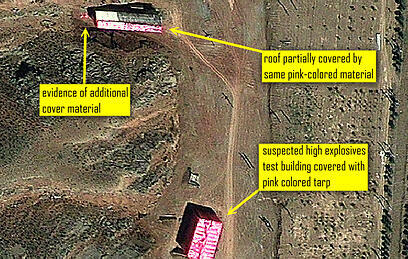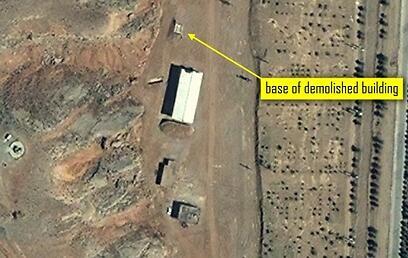Getting your Trinity Audio player ready...
Beyond Iran's admission of two soldiers killed, including an officer equivalent to the rank of major, Iranian sources informed The New York Times on Saturday afternoon that Israel successfully struck the secret military base at Parchin on the outskirts of Tehran.
"One of the drones hit, while others were shot down," they claimed. This base, also referred to as a "security facility" in various reports, is known for developing missile and suicide drone technologies, alongside nuclear technologies.
The Israeli strike involved dozens of fighter jets and aircraft, reportedly focusing on 20 different targets. According to the IDF, the operation targeted military complexes, air defense systems, missile production facilities, and ground-to-ground missile launchers in the Tehran province, as well as in the Khuzestan and Ilam provinces in western Iran.
Iranian sources also told The New York Times that Israel attacked an S-300 air defense battery stationed at Imam Khomeini International Airport, which provides protection for parts of the Iranian capital. They added that at least three missile bases of the Revolutionary Guards were damaged in this round of Israeli strikes.
The Parchin area, located approximately 18 miles east of Tehran, has been a focal point of Iran's military activities. Our analyst, Ron Ben-Yishai, highlights that Iran has previously conducted experiments in this area aimed at enabling the production of nuclear weapons—the nuclear explosive device.
While there is no solid information indicating Iran has renewed its efforts to develop a nuclear warhead, if reports of the Parchin facility being attacked are accurate, the goal seems to have been to thwart Tehran's ability to conduct experiments that would advance it in producing a bomb, should it decide to do so.
According to foreign reports, this is not the first time Israel has targeted this mysterious Iranian base. In May 2022, an "incident" was reported there, resulting in the death of engineer Ihsan Gad-Beigi.
The New York Times reported then that the facility was attacked by drones. According to the report, quadcopter suicide drones exploded on a "building of the Iranian Defense Ministry, where research is conducted for the development of drones and unmanned aerial vehicles." The newspaper noted that the method of operation mirrored previous Israeli strikes, to which Israel declined to comment.
A few days after the strike, the Iranian military announced that Iranian Chief of Staff Mohammad Bagheri and Iranian Army Commander Abdolrahim Mousavi visited a "subterranean drone base" whose location was undisclosed.
An Iranian state television reporter covering the visit mentioned that the visit took place on a Thursday and involved a 45-minute helicopter flight from Kermanshah in western Iran to the "secret underground drone facility." He reported that he was allowed to remove his blindfold only upon arrival at the base, allegedly leaving him unaware of its location. Photographs released by Iranian television showed rows of drones armed with missiles inside a tunnel, reportedly hundreds of meters underground.
The base where nuclear ambitions were nurtured
In a severe 2011 report by the International Atomic Energy Agency, about four years before the signing of the nuclear agreement, it was noted Iran built a facility at the Parchin military base for conducting hydrodynamic experiments, indicative of potential nuclear weapon development. The base was highlighted as a main focus of Iran's nuclear program, with reports of efforts to simultaneously detonate explosives integral to the bomb mechanism, alongside hydrodynamic experiments related to nuclear weapons development.
At Parchin, it was claimed that there exists a special facility where Iranians attempted to develop the explosive casing to encase enriched uranium hemispheres, initiating the nuclear reaction. Ben-Yishai noted that this casing must explode simultaneously with precision measured in nanoseconds, requiring special detonators known as krytrons, which time the explosion and thus initiate the reaction—resulting in a nuclear explosion.
In the months following the severe report, assessments and satellite images suggested Iran was cleansing the Parchin site of evidence of military-related nuclear activity. Among other actions, the Institute for Science and International Security revealed satellite images showing a "pink cover" over a building at the military base, which UN inspectors sought to visit. The cover likely allowed Iran to clean or operate in the facility in a manner that prevented satellite tracking. A Western envoy said at the time that purification activities at Parchin were "intensifying," casting doubt on whether IAEA inspectors could find solid evidence there—even if granted access to the military site.
It became evident that the Iranians sought to conceal the existence of experiments on the casing and miniaturization of the bomb intended to allow its insertion into the warhead of ballistic missiles. They attempted to remove soil layers in the area to obscure radioactive traces emitted during the use of nuclear materials, and also flushed the area with strong water currents.
In fact, only in September 2015, four years after demanding access to the facility, did IAEA officials finally gain entrance—two months after the nuclear agreement was signed with world powers.
That said, Iran has numerous underground facilities, some of which have been exposed in recent years. These underground bases typically house various types of drones, alongside missiles and electronic warfare systems, often located at significant depths underground. Additionally, nuclear development sites have been relocated underground following previous strikes.
Regarding air bases, according to Al-Jazeera, Iran possesses dozens of air bases spread across its western, eastern, and southern command regions. These bases are associated with either the Iranian Air Force or the Revolutionary Guards and support various military missions.
Get the Ynetnews app on your smartphone:





